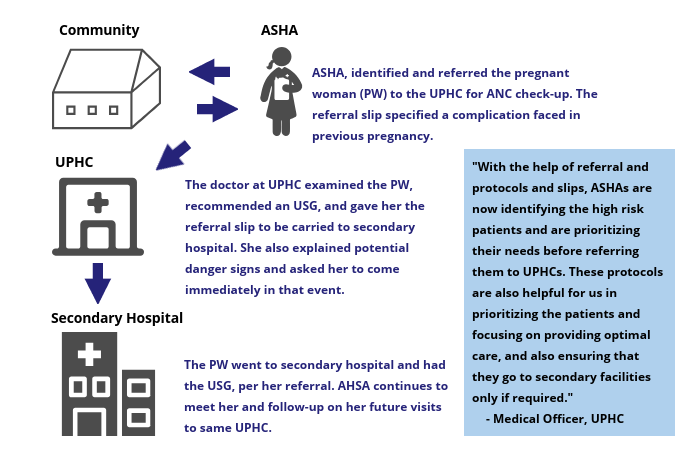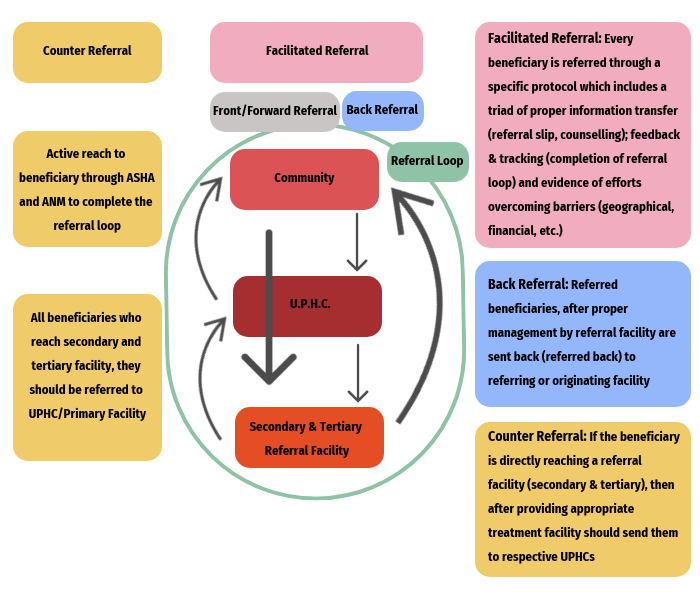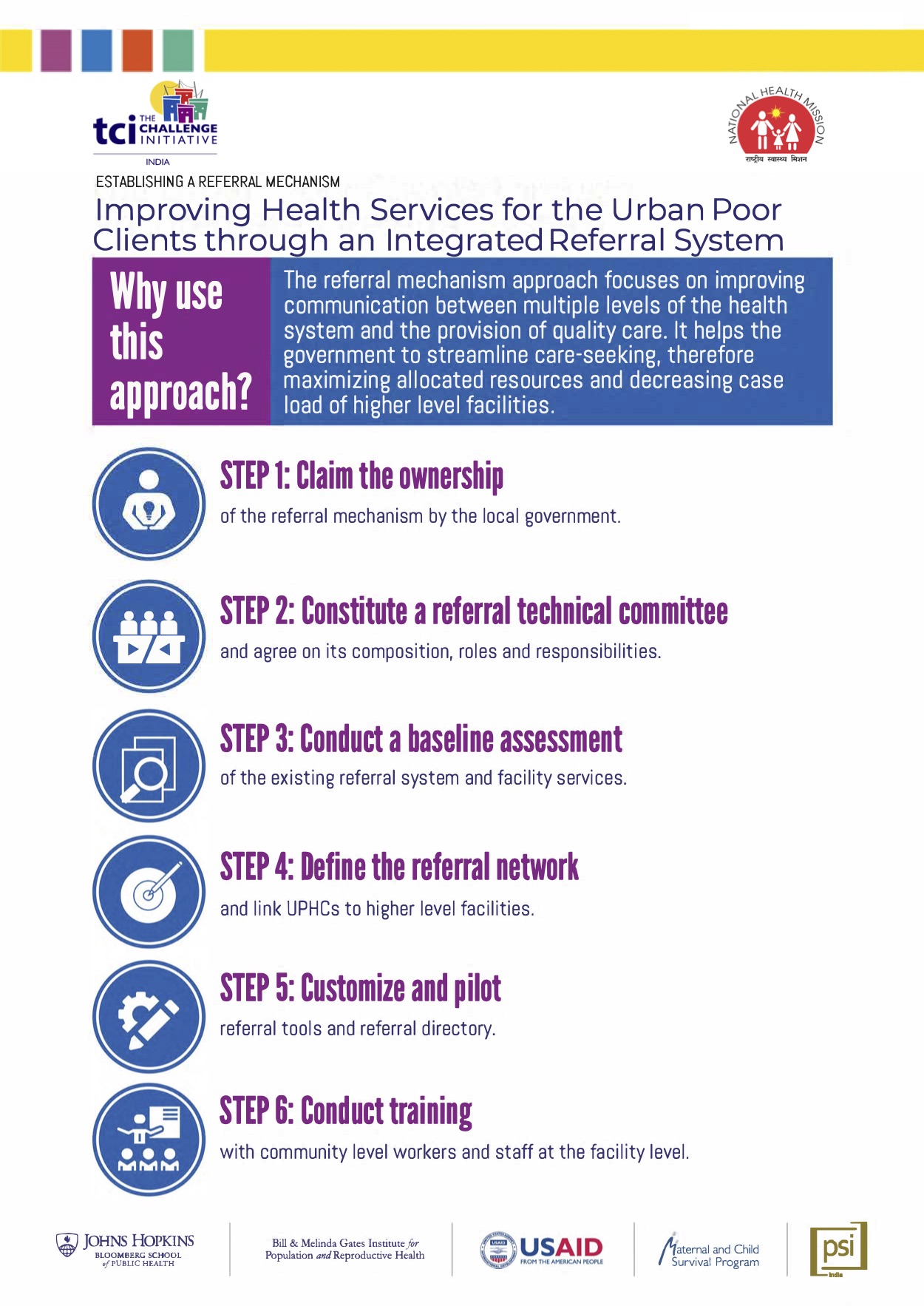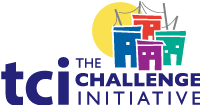India Toolkit: Service Delivery
- Home
- Help and Support
- Close
- Toolkits
- Global Toolkit
- AYSRH Toolkit
- Hub Toolkits
- Core High-Impact Practices
- Gender Essentials Mini Course
- Close
- Resource Collection
- Community of Practice
- Coaching
- Log In/Register
- My Profile
- English
Establishing Referral Mechanism to Deliver Reproductive, Maternal, Newborn & Child Health Services in Urban India
 Purpose: To provide specific guidance on integrating the facilitated referral system into existing service delivery to improve health service access, utilization and quality in facilities serving the urban poor.
Purpose: To provide specific guidance on integrating the facilitated referral system into existing service delivery to improve health service access, utilization and quality in facilities serving the urban poor.
Audience:
- State officials
- Chief Medical and Health Officers (CMO/CMHO/CDMO/CS)
- Chief Medical Superintendents (CMS)
- Nodal Officers – RMNCH
- Urban Health Officers, Program Managers
Background: The referral mechanism approach focuses on improving communication between multiple levels of the health system and the quality of care provided. It helps the government to streamline care-seeking, therefore maximizing allocated resources and decreasing case load of higher level facilities and at the same time it helps patients to receive optimal health care at appropriate level, as far as possible closest to home. In India, the National Health Policy (NHP) 2017 and the National Urban Health Mission (NUHM) framework 2013 are the key policy drivers that emphasize on the establishment of an appropriate referral mechanism as one of the key components to deliver continuum of care in urban areas.
Intended Impact of Referral System
- Individuals receive care and referral to appropriate facility, at the community level through ASHAs.
- With a referral slip, individuals are seen more quickly at health facilities.
- Referral slips provide information to providers at all levels, so they know what the individual has received.
Often health initiatives focus on behavior change at the community level and generating demand for seeking care. The referral mechanism focuses on behavior change of the caregivers and care managers and ensures that care is: Patient-centered, respectful, safe, appropriate and hight quality.
Referral Pathway in Urban Settings
Referral pathway in urban settings is similar to the rural referral pathway. ASHA worker is the first point of contact for a community. The urban primary health center (UPHC) is the primary center where patients can be observed by the medical officer. Secondary and tertiary care facilities are the next referral points where patients can be referred for advanced treatment.

Referral Mechanism Established by TCIHC
Pune city in Maharashtra state is the first city in India where a referral system was established. When TCIHC intended to implement the referral mechanism in Madhya Pradesh, the model from Pune city was adapted for implementation. The referral tools and facility specific referral plans were taken from Pune city model. However, the community level referral mechanism was introduced by TCIHC while it was being implemented in Indore city of Madhya Pradesh. In addition, the feedback mechanism was also strengthened through back and counter referral in order to measure the impact of the referral system. The below figure shows the TCIHC referral system model that was implemented in cities of Madhya Pradesh state.

Guidance on Establishing and Implementing a Referral Mechanism
The following steps should be taken and/or adapted in order to establish and implement a referral mechanism in the urban health system.
- Claiming the ownership of the referral mechanism by the local government
- Constitution of referral technical committee – its composition, its roles and responsibilities
- Baseline assessment of existing referral system and facility services
- Defining referral network, linking UPHCs to higher level facilities
- Customization of referral tools and referral directory
- Piloting of referral tools
- Training of community level workers and staff at the facility level
- Implementation of the referral mechanism with handholding support
- Inter-phase meetings of facility staff and community workers
- Partnership with medical colleges and nursing institutions
- Data generation and monitoring of referral mechanism
- Feedback mechanism and quality improvement
- Developing referral champions in district
Roles and Responsibilities Towards Implementing a Referral Mechanism
Role |
Responsibility |
| CMHO/CMO |
|
| Secondary/Tertiary facility in charge |
|
| Medical Officer of UPHC |
|
| Community Workers (ASHA/ANM) |
|
Monitoring of Referral System Implementation
Implementation of referral mechanism can be monitored regularly by including it as a regular agenda of Referral Technical Committee, City Urban Health Department meeting and monthly meeting of Medical Officers. The following indicators should be reviewed:
- Number of referrals from community to UPHC
- Number of referrals from UPHC to higher level facility
- Proportion of high risk delivery case handled using referral mechanism
- Proportion of high risk newborn treated with referral mechanism
Further, regular visits from facility staff to community should be made to ensure that the field level workers are using the referral slips to refer patients from community. Regular handholding support should also be extended to them to improve their performance. Regular inter-phase meetings should be held to monitor the progress of implementation of the referral system.
Cost Elements
The following elements are required for implementing the referral mechanism are provided below along with their Program Implementation Plan (PIP) codes. In addition to this, support can also be sought through flexi pool budget.
| FMR Code | PIP Budget Head |
| U.9.5.8.2 | Training (Community Referral) |
| U.9.5.8.3 | Facility Referral |
| U.9.5.8.4 | Creation of referral plan |
| U.16.2.2 | Monitoring meeting (Data collection and documentation) |
| U.11.1 | Print media |
| U.16.8.2.3 | Administrative cost (Meetings and workshops, etc.) |
Sustainability
Sustainability of a referral mechanism can be achieved through the following measures:
- Ensuring that financial resources required for the referral mechanism are included in the annual PIP.
- Establishing the administrative guidelines for the use of the referral slips in routine referral.
- Monitoring of the referrals during monthly meetings at the facility level.
- Ensuring the routine refresher trainings for the implementation of the referral mechanism.
- Ensuring prioritization of patients coming with referral slips at the higher facility level.
- Moreover, constant support and motivation to community workers and facility staff to optimally implement the referral mechanism to streamline service provision.
Disclaimer: This document is not prescriptive in nature but provides overall guidance for possible adoption and adaptation. The downloadable versions of this document are slightly modified to make it state representative for Madhya Pradesh and Odisha, respectively.
TCI APP USERS PLEASE NOTE
You will only receive CERTIFICATES by email – when earning a score above 80% – and will not be able to view or print a certificate PDF from the TCI app.
Test Your Knowledge
Earn a Certificate
Quiz Summary
0 of 5 Questions completed
Questions:
Information
You have already completed the quiz before. Hence you can not start it again.
Quiz is loading…
You must sign in or sign up to start the quiz.
You must first complete the following:
Results
Results
0 of 5 Questions answered correctly
Your time:
Time has elapsed
You have reached 0 of 0 point(s), (0)
Earned Point(s): 0 of 0, (0)
0 Essay(s) Pending (Possible Point(s): 0)
Categories
- Not categorized 0%
- 1
- 2
- 3
- 4
- 5
- Current
- Review
- Answered
- Correct
- Incorrect
-
Question 1 of 5
1. Question
The focus of the referral mechanism is to streamline care-seeking, and to help patients receive quality care as close to home as possible given the appropriate level of the facility.
CorrectIncorrect -
Question 2 of 5
2. Question
A component to ensuring sustainability of a referral mechanism is prioritizing patients who come in with referral slips at the higher facility level.
CorrectIncorrect -
Question 3 of 5
3. Question
Which of the following is a step for establishing and implementing a referral mechanism?
CorrectIncorrect -
Question 4 of 5
4. Question
How useful did you find the information and/or tools presented on this page? Please write your response in the box below using one of the following phrases: Very useful, Useful, Somewhat useful, Not useful.
Feel free to comment on why you made that choice.
-
This response will be awarded full points automatically, but it can be reviewed and adjusted after submission.
Grading can be reviewed and adjusted.Grading can be reviewed and adjusted. -
-
Question 5 of 5
5. Question
How do you intend to use the information reviewed and/or tools that you accessed?
-
This response will be awarded full points automatically, but it can be reviewed and adjusted after submission.
Grading can be reviewed and adjusted.Grading can be reviewed and adjusted. -



